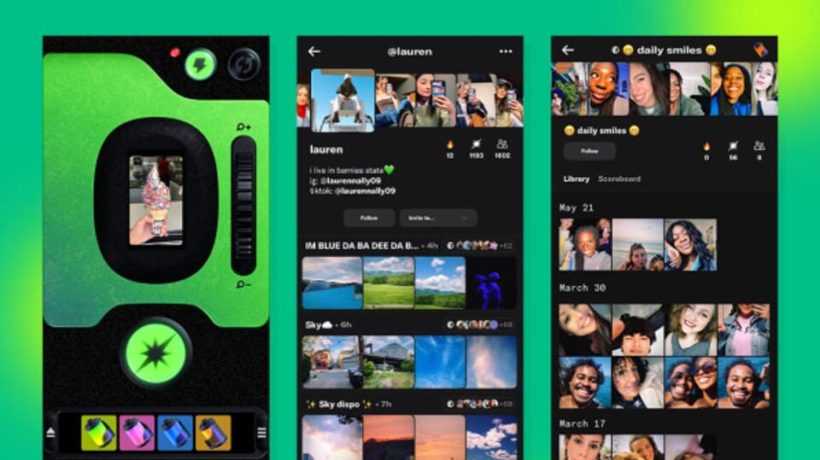BY
Fast Company Contributor
6 MINUTE READ
Dispo, a photo-sharing app that allows users to take retro-style pictures that they can’t see until 9 a.m. the next morning—much like a disposable camera, is a fresh take on the single-most-popular digital activity for a generation stressed out by the pressures of Instagram perfection. Dispo, a photo-sharing app that allows users to take retro-style pictures that they can’t see until 9 a.m. the next morning—much like a disposable camera, is a fresh take on the single-most-popular digital activity for a generation stressed out by the pressures of Instagram perfection.
Just four months ago, Dispo, the photo-sharing app that allows users to take retro-style pictures that they can’t see until 9 a.m. the next morning—much like a disposable camera—looked unbeatable. It had a fresh take on the single-most-popular digital activity for a generation stressed out by the pressures of Instagram perfection. It had the funding to grow and a buzzy valuation of $200 million for an app still in beta. It scored a splashy New York Times profile. Most of all, it had David Dobrik, perhaps the most successful digital creator of the last decade, whose stardom emerged first on Vine, blossomed on YouTube, and then exploded further on TikTok. The likable 24-year-old star who was once dubbed “Gen Z’s Jimmy Fallon” was a multimillionaire with a golden touch, and now he was going to build a new social network.
Then the calendar turned to March, and Dobrik went from one of the most beloved and successful social media stars on the planet to one of its most disgraced. A member of Dobrik’s Vlog Squad—the posse of guys and gals with whom he shoots Jackass-style videos—was accused of raping a woman while making a video for Dobrik’s YouTube channel. (Dobrik responded to the charges in an apology video in which he said that “consent is something that’s super, super important to me . . . I’m sorry I let you down.”) As a result of the allegations, Dobrik stepped down from Dispo, and Spark Capital, which had led its $20 million series A funding round, severed ties with the company.
The company could have vaporized. Or rebranded. But Dispo CEO Daniel Liss, a Harvard and Stanford alum who worked in politics before turning to tech, didn’t panic. In the wake of the turmoil, Liss says, he and his team “sat down for a couple weeks. We said, ‘okay, we’re putting marketing on hold.’ We’d gone from feeling like the world was on fire, we were top of the App Store, there was euphoric press. So we were kind of holding our breath.” Then he and the Dispo team—all of whom remained at the company—decided to dig in and continue to work on their product. Sure, their greatest branding tool was now gone (Dobrik has amassed more than 18 million YouTube followers and 25 million-plus TikTok fans), meaning millions more would have to be spent in marketing dollars. But as they put their heads down and thought through what Dispo was all about, they realized that the answer went far beyond any one person.
The company’s mission—to move beyond the Facebook and Instagram era of curated images of perfect-seeming lives—had only become more crystallized in the wake of the scandal.
The result of that introspective period, which included a series of conversations to reassure investors, including Sofia Vergara, Weekend Fund, and Shrug Capital, has led to a relaunch of sorts for Dispo. Although the app has remained available to download this whole time, Dispo has not done any promotion or outreach over the past few months as it instead focused on building a product that aims to be more than just a really fun way to take and experience photographs. Indeed, new features and an amplification of its overall message makes it clear that the app is as much about righting the wrongs of Big Tech as it is about snapping pics.
This vision helped Dispo—whose team is majority female and majority people of color—retain all of its other original investors, also including Seven Seven Six, Reddit cofounder Alexis Ohanian’s venture fund—though Ohanian has said that any profits he sees from this investment in Dispo will be donated to “an organization working with survivors of sexual assault.” Liss and company also attracted a new group of advisors and investors, including photographers Annie Leibovitz and Raven B. Varona; NBA stars Kevin Durant and Andre Iguodala (via their respective investment vehicles Thirty Five Ventures and F9 Strategies); Endeavor; and Angelica Nwandu, CEO of the Shade Room.
Liss says that Dispo is “the antithesis of this curated, perfect aesthetic that has dominated the last decade,” thanks to forces like Instagram and Facebook. “We believe what we’re capturing now is this new wave of social media. That’s why we’re so excited to be at the vanguard of it. We all know that Hollywood, fashion, art—there are cycles in culture. Social media is so young, we’re actually heading into its first-ever cycle, which is back to the beginning.
“A lot of what we’re doing feels reminiscent of the early days of social media, but there are other parts we’re hoping to get right from the absolute beginning, which is a much greater emphasis on trust and safety; a much greater emphasis on thinking critically about the impact the product is having on a person’s mental health. The early days of social media were all about ‘move fast and break things.’ Our thought is, ‘move fast and build things.’ How can you create something that is additive and not just destructive for the sake of growth?”
PHOTO SHARING’S NEW WAVE
The trend toward spontaneous and imperfect interactions on social media has been gaining steam with the rise of companies like TikTok and Clubhouse, where conversations take place live and unedited (in contrast to the podcast model). In the photo-sharing space, Poparazzi, an app whose camera function won’t let you take front-facing selfies and that forces you to fill your profile only with pictures others have taken or uploaded of you, debuted at No. 1 on the iPhone app store in the U.S. in late May, reaching approximately 1.1 million downloads in the U.S. and 2 million globally its first week. Meanwhile, BeReal, an app that’s taken off in France and that asks users to post a photo of themselves once a day by using both the selfie camera and the outward-facing camera on the backside of the phone—thus creating a more realistic image—is valued at $150 million following a $30 million investment from Andreessen Horowitz and Accel. All of these companies create the first real threat to the multibillion-dollar ecosystem of Instagram, which along with Snapchat—the last notable innovation before TikTok—have proven to be impenetrable to competitors.
Many in Silicon Valley believe this is about to change. “We’re in a scenario where the culture, especially consumer social product culture, is driven largely by teenagers—it always has been and will be,” Ohanian tells me in an interview. “And that is a vulnerability because this generation of teens, Gen Z, has grown up in the shadow of a lot of problematic [issues with Big Tech] . . . things that are leading them to seek alternatives. So I think there’s a huge opportunity for a culture shift just because there is a massive market of digitally native, smartphone-wielding content creators.”
And those creators are hungry for “the next-generation photo-sharing app that prioritizes living in the moment as opposed to living on your phone during the moment,” Ohanian continues. “Where you take a bunch of photos, make them perfect, and just shove them off to people who are you don’t really care about.”
Raven B. Varona, the official photographer for Beyonce and Jay-Z’s On the Run II Tour, said of her decision to invest in Dispo: “There is a joy that comes from capturing a moment unplanned and unrehearsed. Every photo that’s given me the greatest happiness came in the moment. I am excited to help build a company giving people more of that.”
Beyond forcing users to take photos without any reshoots or filters—you simply shoot a roll of photos and see the results the next morning—Liss and his team have worked to avoid adding any features that can lead to angst and a negative sense of self on social media. For example, the number of people someone is following on Dispo is hidden. “If you talk to the average teenager, they obsess about what’s known as their ratio on Instagram—the number (of people) they follow versus who follow them,” Liss explains. “It’s desirable to have more people following you. That behavior has been ingrained in us by Oprah, who follows nobody, and Beyoncé, who follows nobody. But for the rest of us, who cares? As a result (of taking that number away), we’ve found people following much more freely and not stressing over how long their following list was.”
RECREATING EUPHORIA
The challenge for Dispo 2.0 is to build back up to that initial “euphoria,” as Liss dubs it, that Dispo experienced when it first took off in Japan last February. At the time, the app was in TestFlight, or soft launch mode, being used by friends of the Dispo team and tech enthusiasts who were quietly trying the app out.
Then word got out in Japan. Overnight, TestFlight maxed out at 10,000 users and “all hell broke loose,” recalls Liss. The app had caught on among locals who grooved on the fun aspect of not seeing the immediate results of their photo sessions, as well as the built-in privacy of the app, which allows users to control which content is public and what’s private. This feature is particularly prized in Japanese culture, where many people have multiple Twitter accounts in order to make a distinction between their professional and nonprofessional voices.
Even better, the success in Japan—where Dobrik is all but unknown—meant that the product was selling itself. Within weeks, Dispo raised that $20 million.
But even since the company went quiet, there have been signs that its success wasn’t just lighting in a bottle. In April, the app reached the top 10 in the app stores in Germany, Japan, and Brazil over three subsequent weekends. Overall, Dispo has surpassed 5 million downloads and 100 million photos taken.
“This past weekend we went top 10 in Mexico, even though we have no staff there,” says Liss. “It just gets picked up somewhere. This is the magic of a viral, digital product. Some teenager gets ahold of it, and they share with their friends and it goes crazy. All of a sudden, we wake up and we have tens of thousands of downloads and happy people who are spreading this product by word of mouth.
“It’s a product we all need,” he goes on. “It untethers you from your phone. It returns us to the way we all used to live.”
Author: Nicole LaPorte. Article originally published on fastcompany.com.















